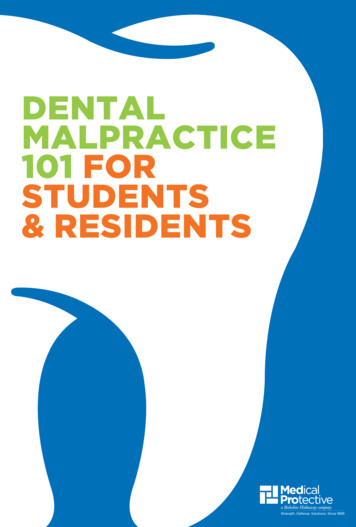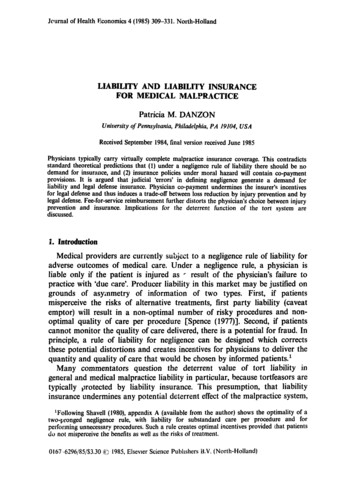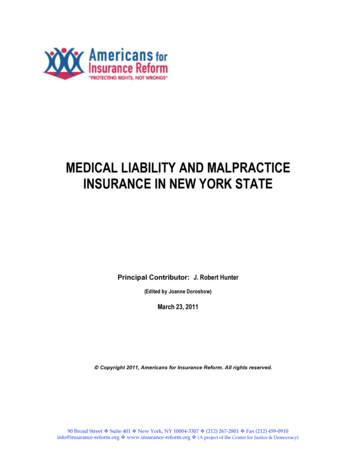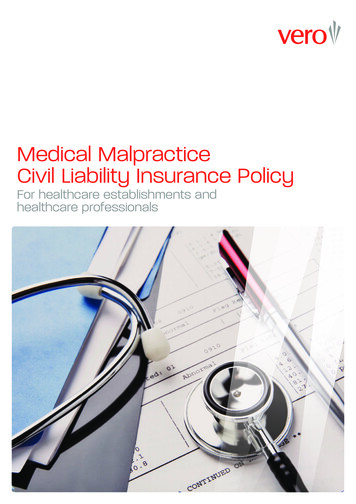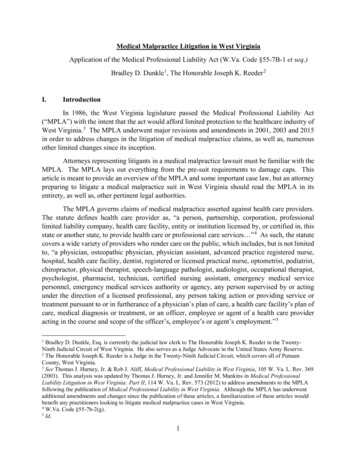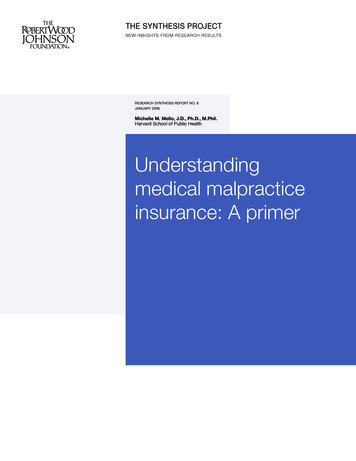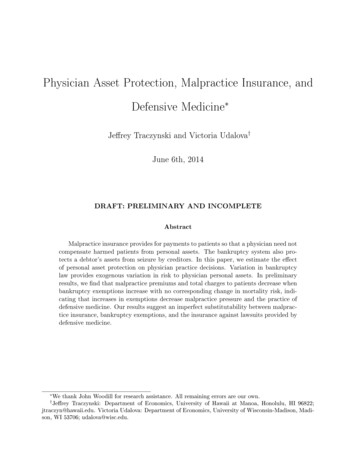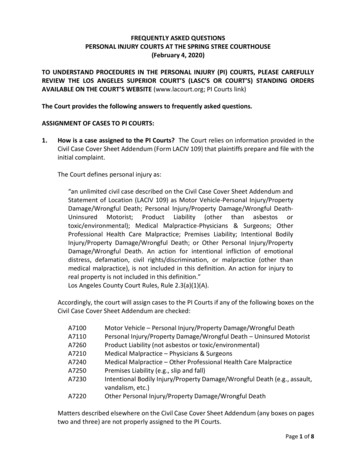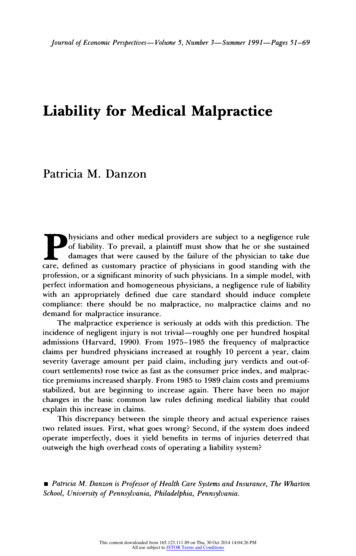
Transcription
Journialof EconomicPerspectives- Volume5, Number3-Summer 1991-Pages 51-69Liability for Medical MalpracticePatricia M. DanzonPhysicians and other medical providers are subject to a negligence ruleof liability. To prevail, a plaintiff must show that he or she sustaineddamages that were caused by the failure of the physician to take duecare, defined as customary practice of physicians in good standing with theprofession, or a significant minority of such physicians. In a simple model, withperfect information and homogeneous physicians, a negligence rule of liabilitywith an appropriately defined due care standard should induce completecompliance: there should be no malpractice, no malpractice claims and nodemand for malpractice insurance.The malpractice experience is seriously at odds with this prediction. Theincidence of negligent injury is not trivial-roughly one per hundred hospitaladmissions (Harvard, 1990). From 1975-1985 the frequency of malpracticeclaims per hundred physicians increased at roughly 10 percent a year, claimseverity (average amount per paid claim, including jury verdicts and out-ofcourt settlements) rose twice as fast as the consumer price index, and malpractice premiums increased sharply. From 1985 to 1989 claim costs and premiumsstabilized, but are beginning to increase again. There have been no majorchanges in the basic common law rules defining medical liability that couldexplain this increase in claims.This discrepancy between the simple theory and actual experience raisestwo related issues. First, what goes wrong? Second, if the system does indeedoperate imperfectly, does it yield benefits in terms of injuries deterred thatoutweigh the high overhead costs of operating a liability system?* Patricia M. Danzon is Professorof Health Care Systemsand Insurance, The WhartonSchool, Universityof Pennsylvania, Philadelphia, Pennsylvania.This content downloaded from 165.123.111.89 on Thu, 30 Oct 2014 14:04:26 PMAll use subject to JSTOR Terms and Conditions
52Journal of EconomicPerspectivesIf the sole function of liability is to provide compensation, it is extremelyinefficient. Tort benefits are unpredictable and therefore provide poor insurance to the victim. Liability also imposes risk on defendants. Moreover, theoverhead rate of the tort system per 1 of compensation is roughly 120 percent(Danzon, 1985a; Kakalik and Pace, 1986), compared to 20 percent for largegroup private health and disability insurance programs. The primary difference is the litigation expense incurred to determine cause, fault and liability.This cost of assigning liability is worth incurring only if there is a deterrencepay off, in terms of injuries prevented because the threat of liability makesproviders more careful.It is widely believed that the deterrence benefits of the malpractice systemas liabilityare minimal and that the costs of "defensive medicine"-definedinduced changes in practice that would not be desired by an informed patient-are high. Many states have enacted tort "reforms," including caps on awardsfor pain and suffering, offset of benefits from other insurance (collateral sourceoffset), limits on plaintiff attorneys' contingent fees, and so on. But there isgrowing interest in more radical alternatives. The Commissioner of Health inNew York recently proposed a no-fault system of compensation for all injuriesarising from medical care, modeled after the workers' compensation system forwork-related injuries (Sack, 1990). Virginia and Florida have enacted no-faultplans for birth-related neurological injuries. The American Medical Association(AMA, 1988) has proposed establishing special administrative agencies to adjudicate medical malpractice claims, replacing the courts, while retaining a(modified) fault-based rule of liability.This paper begins by reviewing the theoretical issues raised by the application of provider liability in the context of medical care. Next, it reviews theevidence on the incidence of injury due to medical negligence, trends in claims,and insurance costs, as well as the evidence on effects of liability on the practiceof medicine. It concludes by briefly discussing policy implications and alternatives to the status quo.Peculiarities of Medical MarketsMedical care is an infrequently purchased service that is often producedunder conditions of severely asymmetric information between producer andconsumer. As Spence (1977) has shown, if customers misperceive risks, a rule ofcaveat emptor leads to nonoptimal levels of risky activities and nonoptimal careper unit of activity. For example, if patients underestimate the risks of cosmeticsurgery and underestimate the risk-reduction benefits of the surgeon spendingadditional time implementing the surgery, there will be too many nose jobs, toolittle care per nose job and consequently too many botched nose jobs. Sincemany medical services are infrequently purchased, it is difficult to become aninformed shopper until it is too late. Because the product is patient-specificThis content downloaded from 165.123.111.89 on Thu, 30 Oct 2014 14:04:26 PMAll use subject to JSTOR Terms and Conditions
PatriciaM. Danzon53service, rather than a mass-produced, homogeneous good, the existence of acore of informed shoppers will not necessarily suffice to police quality foreveryone, especially if physicians can tell who is and who is not informed.There are coarse screens to protect against incompetence or systematic misconduct: licensure as a condition of practice, peer review, hospital credentialingcommittees, reputation and referral networks and, more recently, quality monitoring by third party payers. But in theory, provider liability could enhanceincentives for care on a case-by-case basis.A negligence rule of liability for failure to take due care (defined as efficientcare) can in theory create incentives for optimal care per unit of activity.However, the level of risky activities may still be nonoptimal if patients misperceive average risk (Shavell, 1980), unless the definition of negligence alsoextends to performing additional "unnecessary" procedures. But in medicalmalpractice and other professional liability, due care is defined in terms ofprofessional custom, possibly because the courts cannot at reasonable costacquire the information necessary to define due care according to a cost-benefitstandard. By definition, a custom standard of liability cannot correct anysystematic nonoptimality in customary care that may be induced by consumermisperceptions. A custom-based standard in imperfectly informed marketscould be either too low or too high. Liability could prevent significant deviations from this standard, which may be a proxy for consumer expectations, butthis would not necessarily result in optimal care.After asymmetric information,a second peculiarity of medicalone that raises further questions about the optimality of themarkets-andcustom standard-is the prevalence of private first party and social insurancethat pays for the bulk of medical care. Over 80 percent of the population hassome form of health insurance, typically with modest co-payment and premiums unrelated to past use (experience rating). Consequently, only roughly 10percent of expenditure on hospital care and 26 percent of physicians' servicesare paid directly out-of-pocket (Levit and Freeland, 1988). Because insurancedrastically reduces the point-of-purchase price of medical care to patients, thisdistorts customary levels of use of services,1 relative to a first best optimum, andmay also distort customary "quality," defined as technologies typically used totreat a particular condition.But the full-information, first-best optimum may not be a relevant standard given the costs to health insurers of controlling moral hazard (Zeckhauser,1970). In addition, the outcome is further distorted by the fact that employercontributions to health insurance are not taxable income to employees, thusproviding the employed population with an incentive to demand excessiveinsurance coverage. Given the prevalence of health insurance that is either fullysubsidized through general tax revenues (Medicare and Medicaid) or heavilysubsidized through the tax system (employment-based private health insurIFor evidence on the eflctsof co-payment on use of medical care, see Manning et al. (1987).This content downloaded from 165.123.111.89 on Thu, 30 Oct 2014 14:04:26 PMAll use subject to JSTOR Terms and Conditions
54Journal of EconomicPerspectivesance), physicians acting as good agents would provide medical services as longas the marginal benefit to the patient exceeds the private marginal cost facingthat patient, which is typically a small fraction of the social marginal cost.The prevalence of heavily subsidized health insurance has several implications for the application of liability rules to medical markets. First, the use of acost-benefit calculus for determining due care would be problematic even ifcourts had good information on the benefits of alternative medical treatments.If liability is to promote efficient resource allocation, the calculus should usesocial costs and benefits. But this may differ from private marginal costs andbenefits to the patient, which the physician acting as a good agent should useand is under some pressure to use, assuming some degree of competition andinformation in medical markets. Use of a social cost-benefit calculus couldcreate unbearable tension between legal standards and medical care markets.But if courts adhere to traditional customary practice, this could undermine recent attempts by private health insurers and social insurance programsto substitute provider incentives for holding down costs for patient incentives.This has been done through use of health maintenance organizations (HMOs),preferred provider organizations (PPOs), utilization review, and so on. In thelong run, these innovative contractual forms offer potentially efficient means ofreducing the deadweight loss generated by patient moral hazard. But theycreate a conflict between what the patient wants when sick and what thephysician or insurer is willing to provide under the terms of the contract.Although suits for withholding services, alleging that the patient was not fullyinformed about the service restrictions under the insurance contract, have sofar been rare, they could become increasingly important in the future. How thecourts resolve such suits may be critical to the feasibility of controlling thegrowth of medical costs within the context of a private markets for medical careand medical insurance.Second, the prevalence of health insurance makes it very difficult todistinguish cost-justified precautions from "defensive" responses to liability.Defensive medicine should be defined as liability-induced changes in medicalpractice that entail costs in excess of benefits and that would not have occurredin the absence of liability. Health insurance leads to the use of many medicalservices that yield benefits less than full social cost because of moral hazard.This is insurance-induced, not liability-induced defensive medicine, but distinguishing the two empirically is difficult. There is concern that heavily insuredpatients have little incentive to refuse any treatment with non-negative benefit,and that physicians therefore engage extensively in such defensive practices toreduce their own risk of suit. One widely cited estimate put the cost of defensivemedicine related to ambulatory care alone at 10.7 billion in 1984, or 16percent of total expenditures on physicians' services (Reynolds et al., 1987).Both the theoretical argument and the empirical evidence on defensive medicineare discussed further below.This content downloaded from 165.123.111.89 on Thu, 30 Oct 2014 14:04:26 PMAll use subject to JSTOR Terms and Conditions
Liabilityfor MedicalMalpractice 55Trends in Malpractice Injuries, Claims, and Insurance RatesThe Frequency of Negligent InjuryTIhe best data on the incidence of injuries due to medical malpractice comefrom two broad-based surveys of medical records of hospitalized patients, thefirst in California in 1974 (CMA, 1977) and the second in New York in 1984(Harvard Medical Practice Study, 1990). The CMA study reviewed records of20,864 patients in 23 hospitals, while the Harvard study reviewed records of31,429 patients in 51 hospitals. In both studies, a stratified random sampleof hospital records were reviewed by experts in legal medicine, to determinethe incidence of any injury due to medical care and the incidence of injury dueto negligence. The findings were quite similar. The California study reportedthat 4.65 percent of hospitalized patients suffered an injury caused by healthcare management; of these, 17 percent (or one in 126 patients) involvednegligent injury.2 In the New York study, 3.7 percent of patients sustained aninjury that resulted in measurable disability. Of these injuries, 28 percent (or 1percent of all hospital discharges) involved negligence.In both studies, most injuries were relatively minor. In the New Yorkstudy, 57 percent of patients recovered fully within a month and 70 percentwithin six months. But 14 percent of medical injuries were fatal, and over halfof these were attributed to negligence. This is almost certainly a downward-biased estimate of the total number of negligent injuries, because hospital recordsmay be inadequate to detect such injuries and because injuries occurring inambulatory settings are excluded, unless they resulted in hospitalization.TIhe California study did not track the injured patients to determine thenumber who subsequently filed suit. However, a comparison of the totalnumber of malpractice claims filed in California in 1975-1978 to the number ofnegligent inijuries implies that at most one in ten of the victims filed a claim,and only 40 percent of these claimants received compensation through the tortsystem (Danzon, 1985a). The New York study actually tracked the injuredpatients. Although the total number of malpractice claims against doctors andhospitals was about 12 percent of the number of negligent injuries, only 6percent of patients identified by the study as having sustained an injury due tonegligence filed a claim. These data suggest that many who sustain an injurybecause of negligence do not file a claim, and that many claims are filed bypeople who have not sustained an injury caused by negligence, at least relativeto the standards of negligence used in this study. Because many of these caseswere still unresolved at the time of the study, it could not assess the ability ofthe litigation system to screen out claims where the study had not foundnegligence.2Ihe data are described in Dauizon (1985a). An injury was defined as negligent based on anevaluation by the reviewers of the likelihood of a jury finding of liability under prevailingnegligence law.This content downloaded from 165.123.111.89 on Thu, 30 Oct 2014 14:04:26 PMAll use subject to JSTOR Terms and Conditions
56Journal of EconomicPerspectivesThe data available are not ideal for understanding the causes of negligentmedical injuries and the ability of the malpractice system to detect differenttypes of error. If certain mistakes are easier than others to discover and proveto a jury, or if small stakes cases are not worth filing because of the costs oflitigation, then the malpractice system will impose uneven penalties on differenttypes of error and may distort the delivery of care. In the CMA (1977) study, 82percent of all injuries were adverse effects of treatment; only 15 percent wereeffects of incomplete diagnosis or treatment. The study concludes (p. 62),"Problems of performance, rather than purely judgmental issues were theoverwhelmingly responsible mechanisms." Similarly, errors in performancewere the most common allegation in claims filed in 1975-1978. Whether or notthis reflects bias in the ability to detect different types of error, it does suggestthat preventing injuries and claims requires being more careful, not simplyperforming more tests or X-rays. The ratio of claims to injuries tends to belower for minor relative to major injuries, and lower for persons over 65. Thisis consistent with the hypothesis that the expected award is an important factorin determining whether a claim is filed.3After the problem of ascertaining the causes of negligent medical injuries, asecond question is whether malpractice claims are largely a problem of aminority of incompetent physicians and low quality hospitals or of occasionalinadvertent lapses by normally competent providers. Studies consistently showthat both factors play a role. Adverse event rates varied 10-fold betweenindividual hospitals, when standardized for patient age and diagnosis (Harvard,1990, p. 4). Analysis of claims experience of groups of physicians indicate that,after controlling for medical specialty, the distribution of claim frequency ismore concentrated than would be expected based on chance alone (Rolph,1981; Nye and Hofflander, 1988; Ellis, Gallup and McGuire, 1989; Sloan et al.,1989).However, while some physicians who have a disproportionate number ofclaims may be of below average competence, other physicians may be suedrelatively frequently because they treat more difficult cases or a larger volumeof patients, in which case they may be of above average competence in someregards. Consistent with this hypothesis, Sloan et al. (1989) report that boardcertified physicians and physicians working longer hours tended to face moremalpractice claims than physicians who are not board-certified.3The partial data on causes of injuries and claims reported so far from the mor-e recent New Yorkstudy are less conclusive. Surgical complications accounted for 47 percent of all adverse events, butthe percent of these attributed to negligence was lower than for non-surgical adverse events (17percent vs. 37 percent). Over 75 percent of adverse events resulting from errors in diagnosis and innon-invasive treatment were judged to be due to negligence; for falls, 45 percent were attributed tonegligence (Harvard, 1990, p. 5). Without knowing the population at risk in each category, thesepercentages cannot be transformed into rates of negligent injury. Ratios of claims to injuries, bytype of injury, are not yet available.This content downloaded from 165.123.111.89 on Thu, 30 Oct 2014 14:04:26 PMAll use subject to JSTOR Terms and Conditions
PatriciaM. Danzon 57But even if it could be shown that the great majority of physicians takeappropriate care most of the time and that most negligent injuries are theresult of occasional mistakes by otherwise competent physicians or the incompetence of a small atypical minority, it certainly would not follow that liability issuperfluous for purposes of deterrence. It is possible that in the absence ofliability, most physicians would be less careful and the occasional mistakeswould be more frequent. Although it is often argued that liability is unnecessarybecause of state professional review mechanisms, Sloan et al. (1989) report thatfewer than 10 percent of physicians with adverse claims experience weredisciplined in any manner. If one assumes that most adverse claims experiencedoes reflect suboptimal care, that seems a low figure. Moreover, the fact thathospital and other peer review procedures have been strengthened in responseto liability suggests that, although in theory these mechanisms could be substitutes, in practice they may be complements.Trends in Malpractice ClaimsThe frequency of malpractice claims (number of claims per 100 physicians)has increased at roughly 10 percent a year for the last two decades, with sharpincreases in the early 1970s and 1980s and slower growth in the second half ofboth decades. Claim severity has risen at roughly twice the rate of increase ofthe consumer price index, with some evidence of disproportionate growth forthe highest stakes cases (Shanley and Peterson, 1983).Some increase in claim frequency can be attributed to changes in thepractice of medical care, in particular, to the increased frequency of surgicalprocedures. Explicit changes in legal doctrine can only account for a smallfraction of this growth in claims. Some of the surge in claims in the early 1970swas associated with pro-plaintiff shifts in law. For example, the abolition of thelocality rule substituted a statewide or national standard for a local standard ofdue care; the abolition of charitable and government immunity exposed voluntary and government hospitals to suit; the doctrine of respondeat superiorextended the liability of hospitals for actions of their employees; and informedconsent was defined as requiring information that a reasonable patient wouldwant, rather than what was customary for physicians to provide. But thesefactors had run their course by the mid-1970s and cannot explain claim growthin the 1980s (Danzon, 1984b, 1986).In response to the malpractice insurance crisis of the mid-1970s, moststates enacted one or more tort reforms. Some of these changes slowed thegrowth of claim costs. In particular, as of 1985 caps on awards and collateralsource offset had reduced claim severity (by 23 percent and 18 percent,respectively), relative to what it would have been in the absence of the reforms.year off theShorter statutes of limitations reduced claim frequency-onestatute of limitations for adults is estimated to reduce claim frequency by 8percent. Collateral source offset has also reduced claim frequency (by 14This content downloaded from 165.123.111.89 on Thu, 30 Oct 2014 14:04:26 PMAll use subject to JSTOR Terms and Conditions
58Journal of Economic Perspectivespercent) presumably because of the feedback effect from lower expected awardto reduced incentive to file claims. Other reforms do not seem to have hadsignificant effects (Danzon, 1986).4 The sharp increase in claim costs andinsurance rates in the early 1980s, after a lull in the late 1970s, prompted a newround of tort reforms in the mid-1980s. Following several years of no or slowgrowth, claim frequency started to rise again in 1989.Although medical and legal factors account for some of the trends in claimcosts, much of the growth remains unexplained. The New York evidence of avery low rate of bringing suit based on valid claims indicates that claim growthover the last 15 years cannot simply be attributed to the "catch-up" filing ofclaims for a larger percentage of negligent injuries. Growth in the number oflawyers per capita is not a statistically significant explanatory factor, aftercontrolling for other attributes of lawyer-dense areas. Danzon (1984b) foundthat urban areas tend to have much higher claim frequency and severity, butthat this urban phenomenon could not be explained by specific observablecharacteristics of urban areas such as income, unemployment, welfare recipiency, or population turnover rates (intended as a proxy for the "physicianpatient relationship"). The growth in frequency and severity of malpracticeclaims parallels to some extent the growth in other types of tort litigation,notably product liability, but pro-plaintiff changes in legal doctrine (see, forexample, Henderson and Eisenberg, 1988) provide a ready explanation ofproduct liability claim growth.Another unanswered question is whether the increase in claim frequency islargely a response to higher expected awards, leaving the increase in awards asthe main factor to be explained. Evidence from workers' compensation (forexample, Butler and Worrall, 1983) shows that claim rates do respond tobenefit levels. A similar supply response is plausible for medical malpractice,although much harder to measure because award levels are not statutorilydetermined. The finding that collateral source offset reduces claim frequency aswell as claim severity is also consistent with the supply response hypothesis.However, caps on awards affect only the few very high stakes cases, so shouldnot be expected to reduce claim frequency, despite a significant effect on claimseverity.The rate of growth of malpractice claim frequency and severity has been ashigh in Canada and the United Kingdom over the last two decades as in theUnited States, although levels remain higher in the United States (Deweeset al., 1989; Danzon, 1990). This growth has occurred in Canada and theUnited Kingdom despite the fact that these countries do not permit contingentfees for plaintiff attorneys, have limits on awards for pain and suffering, haveTIhese estimates are the average effect over the period 1976-1985. Since somiie refomnis wereunder challenge during part of this period, these estimates may uniderstate fuill long-runi effects ofthe reforms; on the other hand, these effects may overestimate the long-run impact if creativelawyers find ways around the constraints.This content downloaded from 165.123.111.89 on Thu, 30 Oct 2014 14:04:26 PMAll use subject to JSTOR Terms and Conditions
Liabilityfor MedicalMalpractice 59lower medical costs and lower rates of growth of medical costs-all factorscommonly cited to explain the growth of U.S. malpractice claims.Since measured changes in the medical and legal environment do not fullyaccount for the growth in malpractice claims, it appears that factors that areharder to quantify play an important role. First, as mentioned earlier, higherpotential awards tend to increase the expected value from marginal claims.Second, there may have been numerous small and subtle changes in case lawand rules of evidence that make it easier for a plaintiff to establish a cause ofaction and get to a jury, which effectively reduces the expected cost and raisesthe expected value of bringing marginal claims. Such hypotheses are plausiblebut are very hard to test.Malpractice InsuranceThe cost of malpractice insurance has risen roughly in step with risingclaim costs, but more erratically. In the early 1970s, premium rates initiallylagged behind rising claim costs, necessitating sharp premium increases in themid-1970s of over 300 percent in some states. In the late '70s, claim costsstabilized and insurance rates fell in real terms. A similar pattern occurred inthe 1980s except that the rate increases were spread over a longer period.Table 1 shows average (across states) annual rates of increase in the cost of basiclimits of coverage ( 100,000 per claim, 300,000 aggregate for all claims in thepolicy year). This understates the increase in the cost of a constant level ofprotection, which requires purchasing higher limits of coverage as awardsincrease. The majority of physicians now buy coverage of at least 1 million perclaim.Over half of the total dollar volume of physicians' malpractice insurance isnow written by physician-owned mutual companies, and some form of selfinsurance is even more common for hospital coverage. The immediate impetusto the formation of mutuals was the withdrawal of commercial carriers inseveral states in the mid-'70s when regulators disallowed the requested rateincreases. However, the survival and growth in market share of these mutualcarriers suggests that they have advantages relative to stock companies in thismarket. Possible areas of advantage are superior ability to distinguish good andbad doctors and valid from invalid claims, which facilitates settlement andcontrol of policy-holder moral hazard. They may also be superior bearers of thecommon component of risk that derives from uncertainty as to social and- legaltrends that affect all policyholders in the pool. To the extent mutuals can assessor pay dividends to their members, depending on the realization of thiscommon risk, this form of insurance may be less costly to policy-holders thancommercial insurance through stock companies, at least if stock companiescannot costlessly diversify the common insurance risk through equity markets(Danzon, 1984a; Doherty and Dionne, 1988) and must hold capital reserves toprotect against such uncertainty. By purchasing reinsurance, mutuals canThis content downloaded from 165.123.111.89 on Thu, 30 Oct 2014 14:04:26 PMAll use subject to JSTOR Terms and Conditions
60Journal of Economic PerspectivesTable 1Average Yearly Increase in Premium Rates for Basic Limits Coverageby Specialty (Percent), 81-821982-831983-841984-851985-861986-87(P- 1.7- - 2.514.811.511.019.314.372.727.2-2.0- 1.36.113.622.713.030.019.123.797.427.9-2.0- 2.27.712.933.819.720.221.813.475.227.3Source: Calculated from HCFA Survey of Malpractice Insurance Premiums. Unweighted averageacross states.GP (General PracticeIM Internal Medicine(,S G;eneral SurgeryOB(, Obstetrics/GynecologyNS Neurosurgetyobtain some of the advantages of diversifying the nonsystematic component ofrisk through equity markets.Given the dominant role of mutuals in the medical malpractice insurancemarket, the allegation that the sharp premium increases reflect collusive behavior by insurers is even less plausible than in the market for product liabilityinsurance.Effects on Patterns of Medical PracticeUnderstanding the effect of liability on physicians' practice patterns andultimately on the rate of negligent injury is critical to measuring the costs andbenefits of the malpractice system. But the evidence is inconclusive because theexisting data are limited. As already noted, the number of iatrogenic injuries(that is, injuries caused by medical care) is not reported in a sufficientlysystematic manner to permit use of either cross-state or time-series variation inlitigation rates to estimate deterrence effects.5'5'I'he New York study attempts to measure deterrence by analyzing the effect on injury rates of'claim filing rates in a prior year, exploiting the within-state cross-sectional variation in claimnratesas a measure of variation in threat of malpractice sui
demand for malpractice insurance. The malpractice experience is seriously at odds with this prediction. The incidence of negligent injury is not trivial-roughly one per hundred hospital admissions (Harvard, 1990). From 1975-1985 the frequency of malpractice claims per hundred physicians increased at roughly 10 percent a year, claim .
